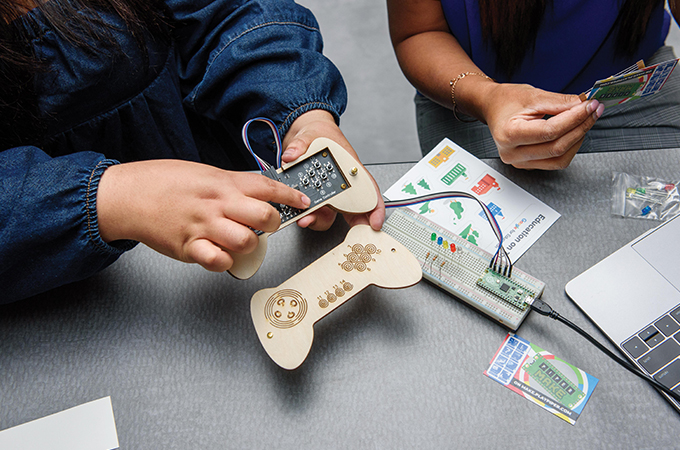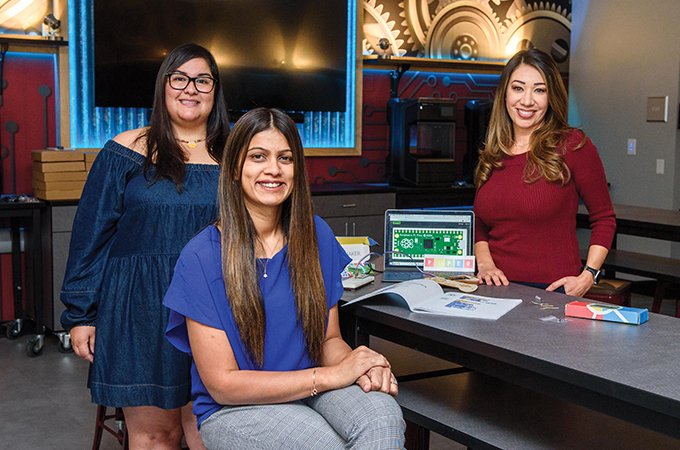As a coordinator in the San Bernardino County Superintendent of Schools (SBCSS) Digital Learning Innovation Department, Sonal Patel ’24 provides professional development and educational technology support to educators and administrators across the county’s 33 school districts that together serve upwards of 450,000 students. As a doctoral student at the University of Redlands School of Education, she is researching ways to expand computer science access and equity. Recently, Patel combined her two interests when she helped organize a free virtual computer science summer camp for elementary school students in partnership with her colleague, SBCSS After School Program Specialist John Duran.
“SBCSS wanted to expand learning opportunities to provide students with a virtual experience that was going to be both fun, student-centered, and educational all at the same time,” says Patel. “I thought it would be great to introduce them to computer science because it allows students to engage with problem-solving and critical thinking, all while students are tapping into their creative abilities.”
A unique opportunity
The idea for the camp, which was made possible by funding provided by the County’s Expanded Learning Department, grew out of a need that Patel identified in meetings with district stakeholders. Previously, the district facilitated a variety of summer camps for students, but this year educators were reluctant to step forward to teach them after the effort of adapting and teaching through the COVID-19 pandemic.
“When I learned that the challenge was recruiting teachers, I thought about graduate students at the University of Redlands who are interested in STEM or enrolled in the credential program who might be interested,” she says.
Patel contacted Professor Nicol Howard and Associate Director of the Office of Student Success Yessenia Yorgesen and asked if School of Education students would like to participate in the camp. Both of them responded with enthusiasm.
Yorgesen says, “When Sonal approached us with the idea for the computer science camp, it made complete sense for the School of Education to partner with the San Bernardino County Superintendent of Schools. Not only would our students gain early fieldwork experiences needed to complete their teaching program, but it was a great avenue to serve the educational community.”
Ultimately, 13 U of R students volunteered to instruct the 80 children who participated. While many of the facilitators had previously taken courses in STEM education, many of them were introduced to new educational technology while preparing for the two-week camp. Patel notes that, because school districts distributed Chromebooks to students at the beginning of the pandemic, reaching students on devices at home was easier than expected—the silver lining of an unusual year.
Superhero Day
The first week focused on block-based coding while the second half concentrated on physical computing, and both instructors and students familiarized themselves with computer science education software and tools such as Google CS First, browser-based coding platform Piper computer kits, and single-board computer kits from Raspberry Pi. After learning the basics of the Python programming language, students were able to start building their own systems.
Shirin Hameister ’22, a camp facilitator and a student in the School of Education’s Learning and Teaching program who plans to be a biology teacher, recalls the camp’s Superhero Day as a highlight. The kids logged onto Zoom dressed as their favorite superhero, created identities, and coded stories for their characters.
“I was really surprised because online formats don’t usually offer a lot of engagement, but it really worked for us,” says Hameister, who developed lesson plans, helped with glitches, and cheered the kids on. “Coding has always been something I was interested in, and I learned a lot during the camp. There were times when facilitators were teaching each other, and others when the kids were teaching us.”
Over the course of the camp, students engaged in problem-solving, critical thinking, and collaborative activities. At the end, everyone had a virtual dance party and students were given extra kits and resources so they could continue to explore computer science on their own.
 A win-win
A win-win
The camp was a success on all fronts—students acquired new skills and facilitators received valuable teaching experience and were compensated for their time. Patel’s office anticipates growth of their computer science events in the future. Next summer, Patel hopes that the camp can be offered in a hybrid format, allowing students and facilitators to work together in person for part of the time. She also looks forward to recruiting more Redlands students to help facilitate future camps.
Using her passion to create valuable experiences for others makes it all worthwhile for Patel. “One of the biggest highlights for me is that we served a diversity of students from throughout San Bernardino County,” she says. “And, since the camp was free, we were really able to open the door of computer science education to all of them. This may not have been possible if students were asked to come in person. I was delighted that school districts supported this virtual summer camp by providing access to computers, wifi, and other resources.”
Because of her involvement, Hameister was offered another opportunity with the San Bernardino County science fair. “I made a lot of connections with school and county administrators who know what kind of resources teachers need,” she says. “But I loved making connections with the kids—it was amazing, and I hope they are inspired to continue pursuing STEM.”
Learn more about the School of Education.






